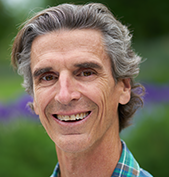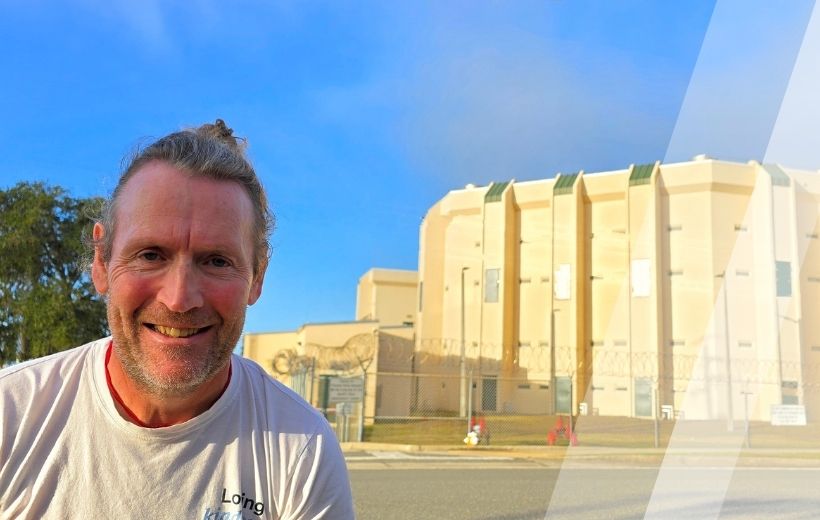“Athletics Brought Me to Meditation”
By Scott Anderson • 3 min read

SOMETIMES IT FEELS like everyone is looking at you — as a competitive athlete, that wasn’t just a feeling. Literally thousands of eyeballs were on me, watching my every move. I was a skinny, sixteen-year-old kid, and the attention was sometimes a cause for celebration (“I’m the center of everything!”), but at other times, it led to freaking-out-I’m-dying levels of anxiety.
As the cool breezes of an early 1980s spring blew into the long days of summer, my wish to be the center of attention had yielded to near-constant paroxysms of anxiety. I wished to become invisible, as the inconsistency of my athletic performances had become the talk of the town. I’d be flying high one week, and the next week, I’d crash into the equipment. I was a high jumper, though my ability to jump high was hamstrung by anxiety.
In my small town, nearly everyone seemed to have a remedy for my inconsistent performances. One coach suggested that I think of winning and positive outcomes, while another coach told me to stop thinking so much. Not surprisingly, neither suggestion was all that effective!
Despite my inconsistent performances, I was a nationally ranked high jumper. When I jumped high — I jumped very high. Unfortunately, I tended to jump the highest at the low-stake meets, while I crumbled when competing at regional and national competitions.
In that era, we called athletes like me a “head case.” The term was by no means complimentary, though it accurately identified what went on inside my own mind. As soon as my name was called to jump over the bar, I was overwhelmed by a torrent of thoughts. Try as I may, I could not make them stop, and the sheer velocity of these thoughts overwhelmed my desperate attempts to rein them in. I literally felt like my thoughts were running wild.
“My dad was my biggest fan, and he tried everything he could think of to help his “head case” kid get back on track. In what he later said was a last-ditch attempt to help me get out of my own way, he introduced me to meditation. “
— Scott Anderson
My dad was my biggest fan, and he tried everything he could think of to help his “head case” kid get back on track. In what he later said was a last-ditch attempt to help me get out of my own way, he introduced me to meditation. Upon returning from a business trip, my dad gave me a set of guided meditations. At the age of 16, I can only imagine my insolence in receiving these cassette tapes, though, against all odds, I put one into my boombox. I found the guided meditation relaxing and listened again the next day. And the following day. And the day after that. Before long, I had worn out the first set of cassettes, and my dad happily bought me another set.
Almost immediately, we all noticed a difference. Though I was still a teenager and prone to the mercurial sufferings of teenage angst, my athletic performance improved dramatically. Thereafter, I placed highly in nearly every meet I competed in — whether locally, regionally, or nationally. My athletic success was also accompanied by greater success in the classroom, and together, they led to offers of athletic scholarships from several colleges and universities. While injuries ended up sidelining my hopes of athletic greatness, it was athletics that brought me to meditation.
Over the years, I’ve told this story dozens, if not hundreds, of times. I often teach meditation to athletes struggling with their own minds, sharing my experience with meditation in the hope that the practice they take up to improve their athletic performance may take root in their lives. No matter how great an athlete may be, their athletic career is often just a small fraction of their life. In my case, the meditation practice took root in my life and continues to bear fruit. I have since come to believe that whatever success I have had — athletically, academically, professionally, and personally — is rooted in the practice of meditation.
May 2025
On May 18, Scott is embarking on a 550 mile bicycle journey to the teachings with Mingyur Rinpoche in Toronto, Canada. Learn more HERE. Follow Scott on his journey on Instagram @scottandersonphd and @tergaronline.

Scott Anderson has practiced yoga and meditation since he was a teenager. Since meeting Mingyur Rinpoche in 2010, he has dedicated himself to the practice and dissemination of Rinpoche’s teachings as one of the founding leaders of Tergar Madison. Scott has a Ph.D. in Kinesiology from the University of Wisconsin–Madison. His research at UW-Madison’s Human Performance Lab explores the interaction of meditation, athletics, and physical recovery, and his teaching activities are at the intersection of physical activity and meditation.
Learn meditation under the skillful guidance of world-renowned teacher Yongey Mingyur Rinpoche at your own pace.


After overcoming self-doubt and joining the Meditation Teacher Program, Mark O’Donaghue is helping those behind prison walls by sharing the radical message that everyone — even those society has forgotten — is already whole, complete, and inherently good.

“It is really important that we try to believe in ourselves. Of course, sometimes we make mistakes, but we can be willing to learn from them. Even if we feel like a failure, we can view that failure as a chance to grow.”

The golden thread that runs through all of the Joy of Living is awareness. Mingyur Rinpoche introduces us directly to awareness by virtue of a practice he calls “open awareness.” To use the traditional analogy of the ocean and the wave, this is an introduction to the ocean — the vast, clean, pure expanse that…
If you enjoyed reading our articles, please join our mailing list and we’ll send you our news and latest pieces.